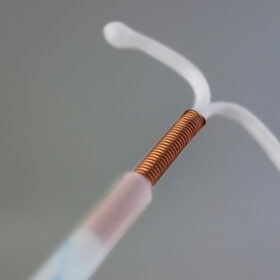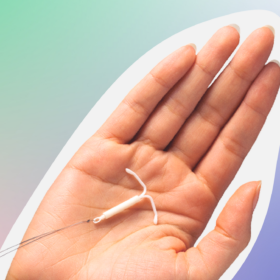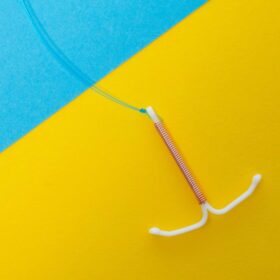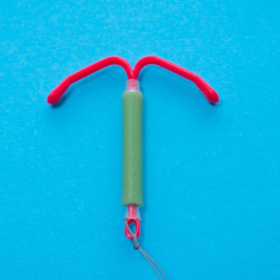
IUS/IUD coil fitting: what to expect
If you have decided that the coil is the right contraception for you, then it may feel like there is a minefield of information when it comes to knowing what to expect from a copper or hormonal coil fitting.
First thing’s first, brush up on the difference between the copper coil (IUD) and the hormonal coil (aka hormonal IUD or IUS) in our complete guide.
What to know before your coil fitting
Where can I get the coil fitted near me?
Coils are available from contraception clinics, some GP practices and sexual health clinics. This sexual health service locator can help you find where your closest service is to have the coil fitted.
When can I get my coil fitted?
If you are having the coil fitted, then many clinics will ask you to avoid sex from the first day of your last period (or for 3 weeks before if you’re not having regular periods) until the fitting. You will be asked to do a pregnancy test on the day to ensure there is no risk of pregnancy.
If you are using another form of contraception consistently and reliably, you may not need to do a pregnancy test, but clinics may have their own protocols and should be able to advise you beforehand.
Both the copper and hormonal coil can be fitted at any time during your menstrual cycle.
Can I have a coil fitted when pregnant?
No you cannot have a coil fitted when pregnant as you are at risk of miscarriage.
How long after coil fitting are you protected from pregnancy?
If a hormonal coil is fitted in the first five days of your menstrual cycle you will be immediately protected from pregnancy. But if it is fitted at any other time in your cycle, then you will be advised to use another form of contraception such as condoms, or abstain from sex for seven days after fitting.
If you switched from another contraceptive method, whether you need to use condoms for seven days after fitting will depend on the type of contraception you were using, if you were using it reliably, and if you’ve had sex in the last seven days, so discuss this with your healthcare professional. You may also find our blog on changing your contraception helpful.
The copper coil is effective at preventing pregnancy straight after it is fitted.
Can I have the coil fitted as a form of emergency contraception?
The copper coil can work as a form of emergency contraception, meaning it can be fitted after sex to prevent pregnancy. In fact it is the most effective method of emergency contraception, more effective than the morning after pill. The copper coil can be inserted up to five days after sex, or up to five days after the earliest time you could have ovulated (your healthcare professional can work this out with you).
Can I ask for pain relief for my coil fitting?
Yes. Everyone should be offered pain relief during a coil fitting and the different options can be discussed with your clinician.
Options include:
- Local anaesthetic spray which is applied to the cervix (the neck of the womb through which the coil is fitted) before the coil is inserted. It takes 3 minutes to work so there’s a slight delay or a chance to talk about the weather
- Local anaesthetic cream (often called by brand name EMLA) can also be used on the cervix but takes 7 minutes to work so is a slightly longer delay – which may increase your nerves
- Local anaesthetic injections can be placed in or around the cervix to reduce pain. However, having the injections themselves can be uncomfortable
- You may be advised to take simple painkillers such a paracetamol or ibuprofen before and after the fitting which can also ease discomfort
- “Vocal local” is a phrase coined by the medical profession meaning that a relaxed environment with a chatty assistant to distract you from the procedure is also useful as a pain relief. This is why it is so important that you feel comfortable, in control and trust the person doing your procedure – as this has the ability to reduce the discomfort you may feel.
There has been lots of discussion in the media around the issue of pain relief offered during coil fittings. We at The Lowdown want women to know our data shows the hormonal and copper coils have the highest overall satisfaction rating of any method on our site (6,500+ reviews and counting) and once it’s fitted 54-61% of women report saying the coils are ‘very good’ or ‘excellent’ – which is over double the proportion that state that for the combined pill or mini pill.
For years The Lowdown have been telling women about the wonders of sprays, gels and anaesthetic injections – and trying to educate them that they can ask for these things during their appointment.
Guidelines from the Faculty of Sexual and Reproductive Health (last updated in 2023) now advise that EVERYBODY having a coil insertion should be offered pain relief, so don’t be afraid to advocate for yourself.
Can I get the coil fitted on my period?
Yes, the coil can be fitted any time during your menstrual cycle.
Can I have a coil fitted with thrush?
Yes, you can have a coil fitted if you have thrush.
Preparing for your coil fitting
Pre-fit consultation
Before having the coil fitted, it’s important that you have a pre-fit consultation, this will help to determine which type of coil is suitable for you, or if you are changing the type of coil you currently have. This may be on the same day as your fitting or beforehand. This will be a chance for your doctor to describe the differences between the copper and hormonal coils and if there is a more suitable one for your medical history and requirements. This is also a great chance to voice any concerns you may have and ask any questions.
At this point you may be asked to have STI (sexually transmitted infection) screening for infections such as chlamydia. You can have an STI and be symptomless. If you have a coil fitted when you have an STI this may lead to a pelvic infection which can be dangerous and cause symptoms such as pain, bleeding and a fever. If an STI is picked up on screening you will be offered treatment and your coil fitting can be scheduled once treatment is complete.
On the day of your coil fitting
How to prepare on the day of your coil fitting?
On the day of your coil fitting some clinics recommend you take a painkiller about an hour before you are due to have the coil fitted. Despite being widely advised, there is no evidence it significantly helps reduce pain during insertion. It may however help to reduce pain or discomfort experienced after the insertion. Non steroidal anti-inflammatory drugs such as ibuprofen may be best for this. Similarly, when The Lowdown interviewed Professor Guillebaud, he recommended using Naproxen, which you may be able to get on prescription beforehand.
It is recommended that you have your breakfast or lunch before the appointment as you would normally. Sometimes after the coil fitting you may feel nauseous, lightheaded or faint, and this can feel worse if you’ve not eaten.
What do you wear to a coil fitting?
We would recommend wearing loose, comfortable clothes to the fitting that are easy to change in and out of.
What to expect at your coil fitting appointment
Before your coil is fitted, your GP or healthcare professional will have a short consultation with you. You may need to do a pregnancy test or STI screen before the coil is fitted. Often there will be an assistant in the room to help your doctor or nurse make sure they have everything they need, and to chat with you and help you during the procedure.
Your doctor or nurse will then check your vagina to see the size and position of your womb, and use a speculum to see the cervix (the neck of the womb at the top of the vagina). Local anaesthetic can be used at this point to help numb the cervix and make the coil fitting procedure less uncomfortable. During this time your vagina will be held open using the speculum.
Once the local anaesthetic has had time to work, your doctor or nurse will use an instrument called a tenaculum to hold the cervix. Then they will measure the length of the womb using a plastic rod called a sound, and following this the coil can be inserted into the womb. This may be uncomfortable but should only last a short time. The coil has two threads that hang through the neck of the womb into the vagina. Your doctor or nurse may trim these for comfort.
It is important to be aware that all procedures like this can trigger what is known medically as a ‘vasovagal response’. This means your heart rate and blood pressure drop and you may feel nauseous, light-headed and even faint. If you feel like this, your doctor or nurse may check your heart rate and blood pressure. These symptoms don’t last long and your healthcare professional will be trained in how to manage this.
Check out The Lowdown’s interview on our Instagram Stories with Professor John Guillebaud (Emeritus Professor of Family Planning and Reproductive Health at University College London) on his advice on having a coil fitted.
It might help for you to read some reviews at The Lowdown, from people like you, who have gone through the same procedure you’re waiting for.
You can also listen to the Hormonal IUS episode of our podcast ‘The Lowdown on contraception where we speak to a GP who fits coils regularly and a Lowdown user who has a Mirena coil.
Our very own Dr Fran also discusses her experience of having the mirena coil fitting in our Sunday Surgery on Instagram Stories.
After your coil fitting
Pain after coil fitting, is this normal?
Having pain after your coil fitting is normal. Some women may experience cramping like pains, which are similar to as if you are on your period. You can take painkillers before having the coil fitted, or afterwards to ease any associated discomfort.
How long does the pain after a coil fitting last?
It is perfectly normal to have some cramping that lasts a few hours after the coil has been inserted. You may experience some mild cramping pain that is on and off in the first few weeks after having the coil inserted.
Severe pain after coil fitting
If you have severe pain after having your coil fitted, or a pain that gets worse or lasts longer than three days then contact your GP or sexual health clinic immediately.
How do I know if the coil is fitted correctly?
At your coil fitting appointment the health professional will teach you how to feel if the coil is fitted correctly. The coil has two thin threads that will hang down through the neck of the womb into the top of your vagina. If you feel for these threads, you can feel that it is in place. You may like to check your threads yourself regularly, i.e once a month after your period or at regular intervals if you do not experience monthly periods.
If your bleeding pattern changes from what might be expected or a period is missed when using the copper coil, you should consider doing a pregnancy test and returning to your healthcare professional to have your coil checked. You can buy 2 Clearblue tests from Amazon (affiliate link).
What to do if my coil has moved?
If you can’t feel the two threads from your coil and you think it may have moved, then you should see a GP or nurse as soon as possible. If the coil has moved then you may not be protected from pregnancy so it is recommended that you use additional contraception such as condoms until the health professional has checked that the coil is back in place.
How long after the coil fitting can I exercise?
The NHS recommends that you wait up to 48 hours before exercising after having a coil fitted.
Sex after coil fitting – How long should I wait?
You should avoid having sex after a coil is inserted for 24 hours, to help the coil to settle. If the hormonal coil was fitted after day five of your menstrual cycle you will also need to use extra protection, such as condoms for seven days.
How long after having the coil fitted can I wear a tampon?
The advice on how long to wait before using a tampon after having a coil fitted varies and is based on reducing the risk of infection. It is sensible to avoid tampons for the first 24 to 48 hours and use sanitary towels for bleeding during this time, although some NHS clinics recommend avoiding tampons for the first 4 weeks after fitting.
Can you use a menstrual cup after having a coil fitted?
The Mooncup manufacturer states that whilst many coil users are able to easily use a menstrual cup alongside their coil, there have been some cases when the coil has been dislodged. They recommend to ensure that you keep checking for the strings of the coils after each period, and to discuss with a medical professional if you think the coil has moved.
Bleeding after copper coil / IUD fitting
You may find that you bleed for a few days after a copper coil/IUD fitting. It is normal to have light bleeding after a coil insertion, but it’s recommended to speak to your doctor if you have heavy bleeding or worsening pain.
What to expect from your periods with a copper coil or hormonal coil
You may find that after having a coil fitted that your periods change and you may also find that you get spotting that occurs in between periods. 51% of our contraceptive reviewers (data retrieved 21.05.24) stated that the copper coil gave them heavier periods, with 39% of The Lowdown reviewers stating that the hormonal coil stopped their periods.
What are the risks of having a coil fitted?
- There is a small risk of getting an infection after the coil is fitted. Seek medical advice if you have pain in your tummy, a high temperature or unusual discharge.
- There is a risk that your body may expel the coil (1 in 20 cases). This occurs more commonly within the first few weeks of the coil being fitted. It is important you know how to check your coil is in place and if you can’t feel your threads use condoms and return to where your coil was fitted for it to be checked.
- In very rare cases (1 in 1000 cases) the coil may perforate the uterine wall. This is very unlikely if you have an experienced doctor or nurse fit your coil, but if you have pain or cannot feel the threads make sure you seek medical advice.
What are the side effects of having a coil fitted?
Copper coil
- Your periods may become heavier, longer or more painful. 68% of 595 Lowdown copper coil reviews stated heavier periods as a side effect (data retrieved 15th June 2025)
- Period like cramps are another common side effect
Hormonal coil
- Your periods may stop or you may have spotting in between periods
- Mood swings
- Breast tenderness
- Skin problems
- 28% of our hormonal coil reviewers stated loss of sex drive as a side effect, 10% had an increased sex drive, whilst 48% had no change (data retrieved 15th June 2025)
To find out the experiences of our reviewers of the copper coil and hormonal coil then read our IUD / copper coil reviews and IUS / hormonal coil reviews. Also check out The Lowdown’s podcast episode where our founder Alice talks to a GP on fitting a coil and a friend on what it’s like to have one.
Our medical review process
This article has been medically reviewed for factual and up to date information by a Lowdown doctor.






